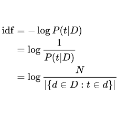Anchors (Ribeiro et al., 2018) is a post-hoc, rule-based interpretability method. For text data, it proposes to explain a decision by highlighting a small set of words (an anchor) such that the model to explain has similar outputs when they are present in a document. In this paper, we present the first theoretical analysis of Anchors, considering that the search for the best anchor is exhaustive. After formalizing the algorithm for text classification, we present explicit results on different classes of models when the vectorization step is TF-IDF, and words are replaced by a fixed out-of-dictionary token when removed. Our inquiry covers models such as elementary if-then rules and linear classifiers. We then leverage this analysis to gain insights on the behavior of Anchors for any differentiable classifiers. For neural networks, we empirically show that the words corresponding to the highest partial derivatives of the model with respect to the input, reweighted by the inverse document frequencies, are selected by Anchors.
翻译:Anchors (Ribeiro et al., 2018) 是一种基于规则的事后解释方法。 对于文本数据, 它建议解释一个决定, 突出一小组单词( 锚), 这样当文件显示时, 模型可以解释相似的输出。 在本文中, 我们提出对Anchors的第一次理论分析, 认为搜索最佳锚值是详尽无遗的。 在将文本分类的算法正规化后, 当矢量化步骤为 TF- IDF 时, 我们给出了不同类型模型的清晰结果, 并在删除时用固定的域外符号替换单词。 我们的查询涵盖了基本规则或线性分类器等模型。 然后我们利用这一分析来为任何不同的分类师了解锁定器的行为。 在神经网络中, 我们实验性地显示, 与该模型在输入方面最高部分衍生物对应的词, 由反文档频率重新加权, 是由 Anchors 选择的 。</s>


